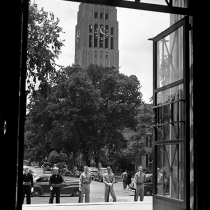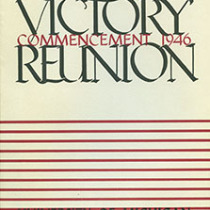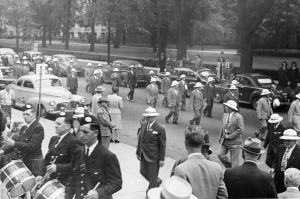News Stories

U-M’s Victory Reunion
Seventy years ago this week, the University of Michigan held a Victory Reunion to celebrate the U.S. victory in World War II and the campus’s transition back to peacetime. The combination graduation and reunion weekend brought upwards of 5,000 alumni back to campus to mark a new era in the University’s history, and to honor the men and women who served so bravely in the war.
by Brian A. Williams
The commencement exercises on June 22, 1946, symbolically marked the return to normalcy for the University of Michigan following the upheaval of the World War II years. The war disrupted many campus traditions while simultaneously spurring the University to an accelerated pace. Gone were time-honored events such as homecoming and alumni reunions held during commencement. Fuel rationing for the war effort precluded such gatherings. Also gone were vacations as the University operated on an accelerated year-round curriculum. Three 16-week semesters were made possible by shortening the Christmas break, compressing the final exam period, and eliminating the spring break. During the war, students could earn a degree in two years and eight months.
One of the most dramatic and visible wartime campus transformations was the presence of uniformed military personnel on campus. The University hosted more than a dozen different military training programs ranging from the Judge Advocate General’s School to the Army Intensive Japanese Language School. Beginning in 1942, the Navy sent more than 4,000 Naval cadets and Marines to campus, while the Army sent more than 8,000 soldiers for training. The last of the wartime military programs, the Navy V-12, closed in June 1946.
Reconversion—or the return of campus to peacetime activities—was in full swing in 1946 following the cessation of hostilities in 1945. Faculty members returned to campus from leaves of absence for wartime research, and veterans flocked back to campus from duty. Earlier that year, the big campus dance, the J-Hop, was held for the first time since 1942. Fraternities, which had suspended operations and leased their houses as residences for soldiers and war workers, were back in operation.
Honoring Wartime Heroes

Army, Navy, and Marine personnel fire a volley on the steps of the Rackham Building at the conclusion of the memorial service. (HS 2205)
To celebrate the military victory and the transition back to peacetime, the University planned a significant celebration around the University’s 102nd commencement. A committee was appointed in January 1946 by President Alexander Ruthven to plan for a special graduation and reunion weekend to be held June 20-22, dubbed the Victory Reunion. Upwards of 6,000 alumni were expected back, including three classes that had reached their Golden anniversary but were unable to celebrate because of the war conditions. Karl Litzenberg, a professor and World War II veteran, was appointed the general chairman of the committee and charged with overseeing an event that would seriously challenge campus and local hospitality resources still hampered by wartime constraints. Among the dozen subcommittees were housing, entertainment, exhibits, transportation, and memorials.
The centerpiece of the Victory Reunion was a memorial service for the 474 Michigan men and women known to have died in the war (ultimately the number would grow to 579 members of the University community who lost their lives). The names of all the dead were published in the program of the Victory Reunion. The list also included degrees or years of attendance, and most tragically, the date and cause of death.
The memorial service was held at 11:00 a.m. on Friday, June 21, in the Rackham Building. Lieutenant Commander John H. Shilling, an alumnus, Navy chaplain, and veteran of the Pacific island campaigns (as well as former pastor of the West Side Methodist Church in Ann Arbor), delivered the memorial address. President Ruthven presided over the service. The solemn service concluded with the playing of “Taps” and three volleys fired by a rifle squad on the front steps of the Rackham Building.
Degrees for All
Saturday’s Commencement was the concluding event of the Victory Reunion weekend. Ceremonies began at 6:00 p.m. in the evening on Ferry Field in what was the first outdoor commencement since 1941. More than 1,700 students were candidates for degrees, including 70 Naval men in the V-12 program. The commissioning of the V-12 men formally marked the termination of wartime training programs on campus.
Secretary of Agriculture Clinton P. Anderson, who had attended U-M from 1915 to 1916, gave the commencement address titled “Shall We Gather the Harvest,” focusing on the renewed interest in education and foreshadowing the impending enrollment bulge due to returning veterans enrolling under the auspices of the G.I. Bill. President Ruthven concluded the ceremonies on a somber note as he awarded posthumous degrees to 18 alumni who were one or two semesters away from completing their degrees when they withdrew to enter the Armed Forces. After singing “The Yellow and Blue,” the band played “Taps” and “Reveille” as the crowd quietly filed out of the Ferry Field stands.
Peacetime and Growth
Final attendance at the reunion was over 5,000, making it the second largest alumni gathering ever, ranking second to the week-long centennial celebration of the University’s relocation to Ann Arbor from Detroit held in 1937. On the reunion’s opening Thursday, nearly 700 people, more than

Six thousand copies of the Victory Reunion program were printed. Included was a list of all the members of the University community who lost their lives during World War II. (HS 13569)
double the usual number, attended the traditional all-class dinner, recast as the Victory Reunion Dinner.
To meet the record demand, Union staff had to hire and train 70 additional waitresses. Fifteen-hundred alumni attended the luncheon in Waterman Gymnasium with another 500 alumni listening to President Ruthven’s post-war plans in overflow space. Classes from all of the schools and colleges held class meetings in every nook and cranny of campus buildings, often doubling up in rooms. In fact, many of the reunion attendees roomed in bunk beds in the dormitories, in rooms only recently vacated by students.
Despite the logistical challenges, the reunion was declared “successful even beyond the hopes of those who worked on its planning and staging.” It would prove to be a good test of resources, for when the fall semester opened, enrollment was at an all-time high, swelled by 12,000 returning servicemen, part of the educational “harvest” alluded to by the commencement speaker.
Peacetime would be a period of unprecedented growth for the University.

